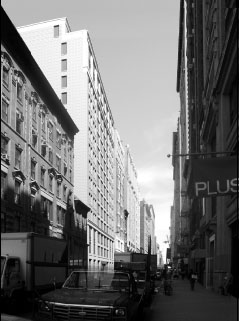
User Note >
Note: While great efforts have been taken to provide accurate and complete information on the pages of CPEP, please be aware that the information contained herewith is considered a work‐in‐progress for this thesis project. Modifications and changes related to the original building designs and construction methodologies for this senior thesis project are solely the interpretation of Daniel Donecker. Changes and discrepancies in no way imply that the original design contained errors or was flawed. Differing assumptions, code references, requirements, and methodologies have been incorporated into this thesis project; therefore, investigation results may vary from the original design.
|WELCOME TO DANIEL P. DONECKER'S PORTFOLIO
BUILDING STATISTICS PART 1: Building Name: 35 West 21st Street
Construction Dates: Cost: Overall building cost is $20,000,000 Project Delivery method: Design-bid-build Architecture – Design and Functional Components: Applicable codes: New York City Building Code (2003) Zoning and Historical Requirements: Building Envelope:
BUILDING STATISTICS PART 2: Structural Systems: Floor System 35 West 21st Street is a typical reinforced concrete residential structure. The floor system is a two way flat plate slab without drop panels or beams. Typical residential floors are 8 inches thick. The bottom is typically reinforced with #5 deformed bars at 12 inches on center each way. Middle strips are typically reinforced with #5 deformed bars at 12 inches on center at the top of the slab, while column strip top bars vary according to span lengths which range from 13’ to 18’. In areas of high shear, slab supports also have studrails to help prevent punch through shear. Typical columns are gravity only, and run the entire height of the building without transfers. On the fifteenth floor, columns lining the exterior balconies are transferred to the 14” slab and then transferred to nearby columns that go down to the foundations. Typical columns are 16”x18” with 8-#7 longitudinal bars and #3 ties at 12 inches on center. Minimum concrete compressive strength is 5 ksi for slabs above ground, and 5.95 ksi for columns. The slab also provides a two hour fire rating. Basement The basement floor is a slab on grade reinforced with 6” WWF 6x6 – W2.0xW2.0. Typical slab on grade thickness is 6”. Roof system The roof slab is 12 inches thick with typical reinforcing like that on all the residential floors. Cooling towers sit on dunnage that consists of 16”x16” concrete piers and galvanized W10x33 steel beams. The remaining mechanical equipment including elevator machines are housed in the bulkhead which consists of shear wall 16 and three transfer columns. The concrete piers and columns are transferred through the 12” slab and into columns below that continue to the foundation. Lateral System The lateral system of 35 West 21st Street is comprised of shear walls in both the North-South and East-West directions of the building. The two towers of the building are built integrally with each other through the two way slab at the basement, ground and second floor. However, at the second floor, the 15 story south tower steps back to allow for an outdoor courtyard, thus breaking the connection between the two towers. Because the connection of the two towers only exists on the first two floors, the towers’ lateral systems were designed separately from each other. It is assumed that the two buildings act separately, and thus do not transfer any torsional moment between the two lateral systems. Typical shear walls are 1’-0” wide and longitudinal reinforcement ranges from #10 at 12” on center at the base of the shear walls to #4 at 12” on center at the top of the building. Horizontal shear reinforcement typically consists of #4 at 12” on center closed loop bars. Foundation The foundation system consists of spread footings for typical concrete columns and large mat foundations for shear walls. On the east side of the building, 240 ton caissons spread loads from the footings to the bedrock below. The caissons are at a minimum drilled 9’-0” into bedrock and are typically 12 inches in diameter. Information regarding mechanical, electrical, construction, and fire protection systems is currently unavailable. |
The Capstone Project Electronic Portfolio (CPEP) is a web-based project and information center. It contains material produced for a year-long Senior Thesis class. Its purpose, in addition to providing central storage of individual assignments, is to foster communication and collaboration between student, faculty consultant, course instructors, and industry consultants. This website is dedicated to the research and analysis conducted via guidelines provided by the Department of Architectural Engineering. For an explanation of this capstone design course and its requirements, visit AE Thesis. |